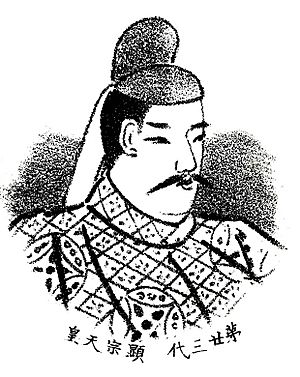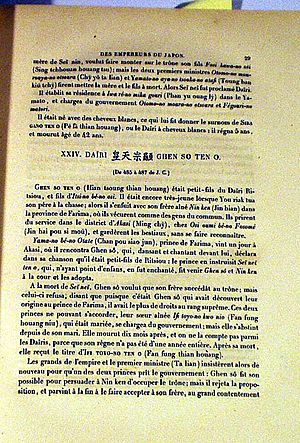Emperor Kenzō facts for kids
Quick facts for kids Emperor Kenzō顕宗天皇 |
|||||
|---|---|---|---|---|---|
 |
|||||
| Emperor of Japan | |||||
| Reign | 1 February 485 – 2 June 487 (traditional) | ||||
| Predecessor | Seinei (possibly Iitoyo) |
||||
| Successor | Ninken | ||||
| Born | 450 Japan |
||||
| Died | 2 June 487 (aged 36–37) Asuka, Yamato |
||||
| Burial | Kataoka no Iwatsuki no oka no minami no misasagi (傍丘磐坏丘南陵) (Nara) | ||||
| Spouse | Naniwa-no-Ono | ||||
|
|||||
| House | Imperial House of Japan | ||||
| Father | Ichinobe no Oshiwa | ||||
| Mother | Wae-hime | ||||
Emperor Kenzō (顕宗天皇, Kenzō-tennō) (born 450, died June 2, 487) was the 23rd Emperor of Japan. He is considered a legendary emperor because we don't have many firm dates or details about his life. People traditionally believe he ruled from February 1, 485, to June 2, 487.
Contents
A Prince in Hiding: Kenzō's Early Life
Prince Woke, who later became Emperor Kenzō, was the grandson of Emperor Richū. His father was Ichinobe-no Oshiwa. When Prince Woke was very young, his father was killed by Emperor Yūryaku during a hunting trip. Because of this, Prince Woke and his older brother, Prince Oke, had to run away to save their lives.
They found a safe place in Akashi, in an area called Harima Province. To stay hidden, they pretended to be ordinary herdsmen. This meant they lived a simple life, far from the royal court.
Returning to the Royal Court
One day, by chance, Prince Oke met someone who helped him reveal his true identity. This person then introduced the two brothers to Emperor Seinei. Emperor Seinei had become the new ruler after his father, Emperor Yūryaku, passed away.
Emperor Seinei welcomed both brothers back to the court. He treated them like his own sons and made them his heirs. This was a big change for Prince Woke and Prince Oke, who had been living in hiding for so long.
Who Will Be Emperor?
When Emperor Seinei died, he didn't have any other children to take his place, only Prince Oke and Prince Woke. Prince Woke wanted his older brother, Oke, to become the next emperor. But Prince Oke refused! They couldn't agree on who should rule.
The important leaders at the court insisted that one of the brothers had to accept the throne. After much discussion, Prince Woke finally agreed to become emperor. This brought a great sense of relief to everyone, as the country had been uncertain about its next ruler. Kenzō was then officially announced as the new Emperor.

Emperor Kenzō is believed to have ruled Japan in the late 400s. However, there isn't a lot of detailed information about him from that time.
Back then, the title "tennō" (Emperor) wasn't used yet. Most historians believe this title started later. Instead, Kenzō might have been called Sumeramikoto or Amenoshita Shiroshimesu Ōkimi. These titles mean "the great king who rules all under heaven." He might also have been called the "Great King of Yamato."
Emperor Kenzō's Reign and Legacy
It is recorded that Emperor Kenzō's capital city was called Chikatsu Asuka no Yatsuri no Miya (近飛鳥八釣宮). This palace was located in an area known as Yamato Province. Today, this spot is thought to be in either Osaka Prefecture or Nara Prefecture.
One important event during Kenzō's rule shows his deep respect for his father. Kenzō made sure that his father's remains were found and reburied in a proper tomb. This new burial place was suitable for the son of an Emperor and the father of a future Emperor.
Emperor Kenzō died when he was about 37 years old, after ruling for only three years. He also did not have any children to take his place. So, his older brother, Prince Oke, became the next emperor after him. Kenzō's wife was Princess Naniwa-no-Ono (難波小野王, d.489).
The exact place where Emperor Kenzō was buried is not known for sure. However, he is traditionally honored at a special Shinto shrine in Osaka. The Imperial Household Agency (the official group that manages royal affairs) recognizes this location as Kenzō's official burial site. It is formally named Kataoka no Iwatsuki no oka no kita no misasagi.
Family Life: Consorts and Children
- Empress (Kōgō) : Princess Naniwa-no-Ono (難波小野王, d.489)
See also
 In Spanish: Kenzō Tennō para niños
In Spanish: Kenzō Tennō para niños
- Iitoyo (Empress Tsunuzashi)
- Imperial cult

